 Oh, my. What on earth am I doing? And why am I doing it?
Oh, my. What on earth am I doing? And why am I doing it?
Thursday, August 19, 2010
Thursday, August 05, 2010
"Back to the Future," Einstein Jump
This is the first of several follow-up posts to our "Back To The Future" podcast on The VFX Show.
Here's an objective breakdown of "Back to the Future"'s first big effects sequence, the first time slice of the movie that sends Einstein the dog forwards in time.
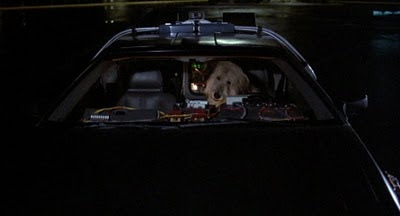
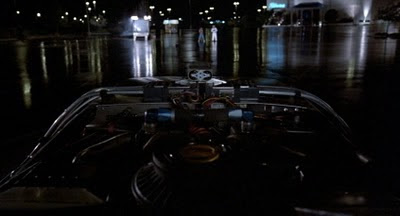
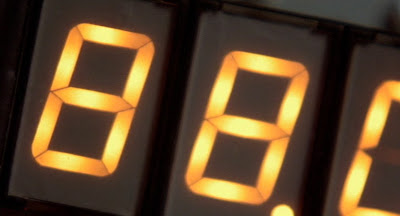
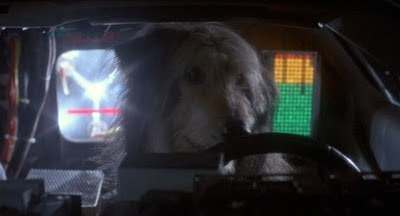
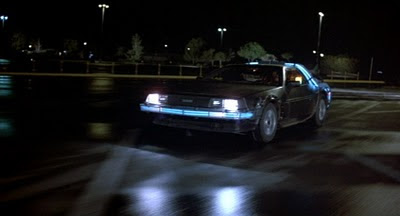 Real photographic background plate of Delorean, with glows and time slice animation created by the animation department at Industrial Light & Magic.
Real photographic background plate of Delorean, with glows and time slice animation created by the animation department at Industrial Light & Magic.
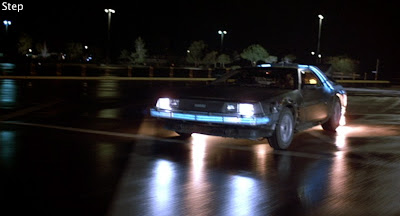 The fire and sparks (and their reflections) were created on the set with special effects rigs attached to the Delorean.
The fire and sparks (and their reflections) were created on the set with special effects rigs attached to the Delorean.
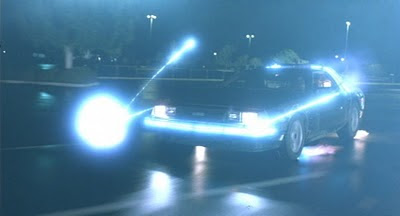
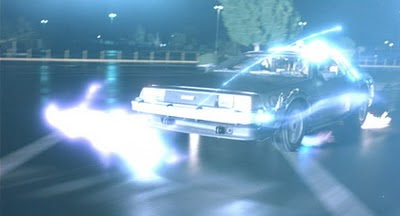
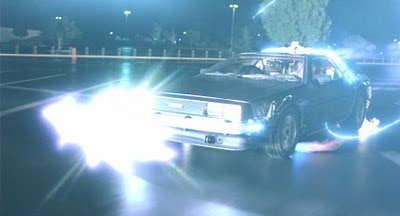 A large strobe light on location provided bright interactive light. Full frame flashing was also achieved in the optical composite.
A large strobe light on location provided bright interactive light. Full frame flashing was also achieved in the optical composite.
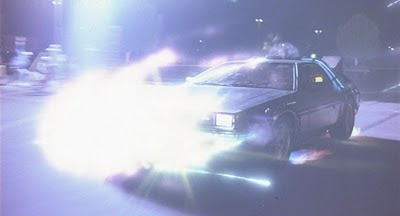 Hey, look in the upper left corner of the screen. Say hi to the crew!
Hey, look in the upper left corner of the screen. Say hi to the crew!
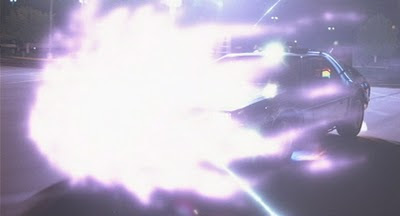
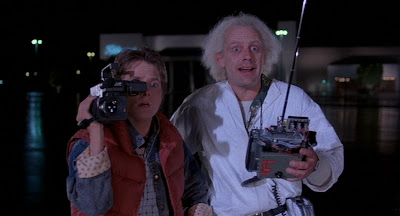
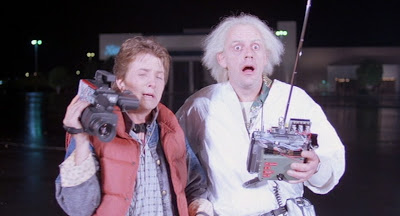
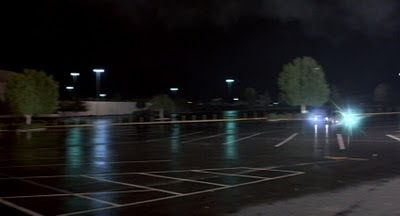 Panning left with Delorean. The car is actually on the set, with animation and effects added optically.
Panning left with Delorean. The car is actually on the set, with animation and effects added optically.
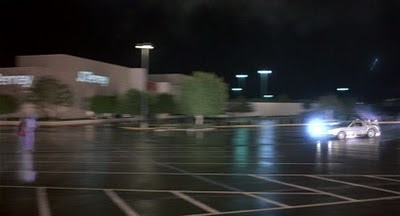 The pan reveals bluescreen-photographed Marty and Doc. The actors were tracked and matted into the shot.
The pan reveals bluescreen-photographed Marty and Doc. The actors were tracked and matted into the shot.
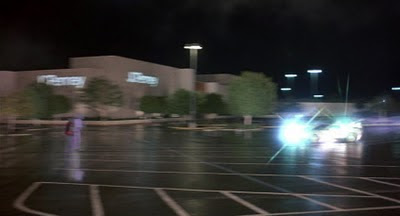
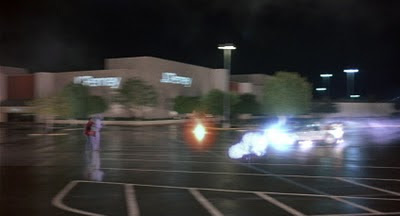
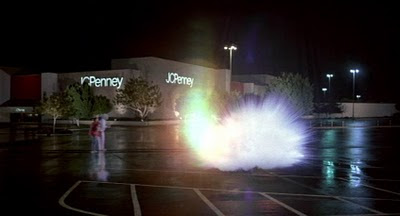 Pan abruptly stops, explosions and flares optically composited to represent time slice effect.
Pan abruptly stops, explosions and flares optically composited to represent time slice effect.
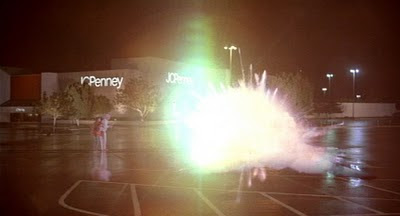
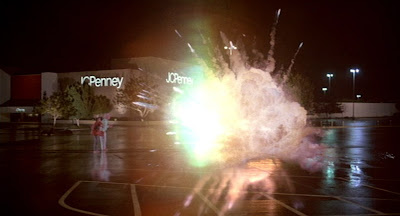 First visible frame of explosion element. The main explosion element has a faked reflection in the wet ground, achieved in the optical composite.
First visible frame of explosion element. The main explosion element has a faked reflection in the wet ground, achieved in the optical composite.
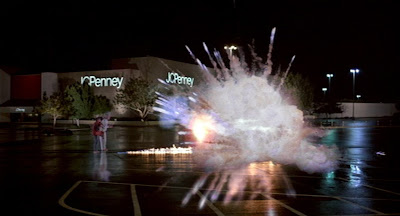 Explosion element runs backwards, giving the impression of an implosion. On-location, live-action ignition of fire trails appear, and are skip printed to appear to ignite much faster than reality would allow, approximating the feeling of 88mph.
Explosion element runs backwards, giving the impression of an implosion. On-location, live-action ignition of fire trails appear, and are skip printed to appear to ignite much faster than reality would allow, approximating the feeling of 88mph.
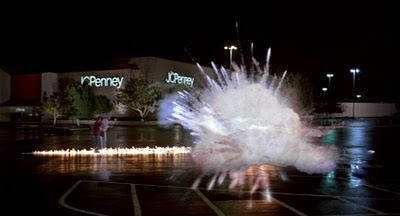 Marty's foreground foot is rotoscoped to allow the fire trail to appear behind his leg.
Marty's foreground foot is rotoscoped to allow the fire trail to appear behind his leg.
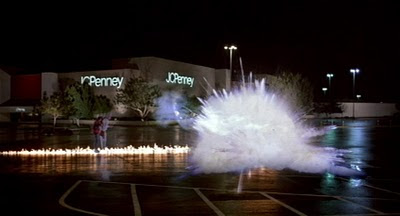
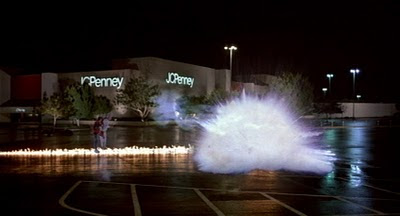 The last frame of the shot.
The last frame of the shot.
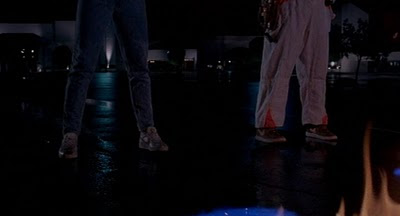 In-camera effect, featuring on-set fire trails, using stunt performers.
In-camera effect, featuring on-set fire trails, using stunt performers.
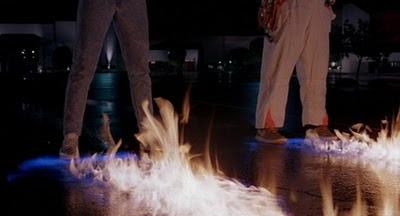 This shot was skip printed in post production to give the ignition the feeling of greater velocity, giving the impression of the Delorean continuing its 88mph journey in a parallel dimension of time. As a result, the fire's motion is somewhat strobey.
This shot was skip printed in post production to give the ignition the feeling of greater velocity, giving the impression of the Delorean continuing its 88mph journey in a parallel dimension of time. As a result, the fire's motion is somewhat strobey.
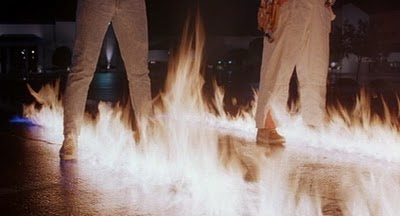 Notice the relative exposure difference between this shot and the shots preceeding and following it. In this shot, the cinematographer exposed the film to feature the fire (or was underexposed in the colortiming or visual effects process), which reveals the internal structure of the fire. In the shots before and after, the actors and environment were the target exposure values; consequently, in those shots, the fire is blown out and overexposed, leaving only hot white fire shapes.
Notice the relative exposure difference between this shot and the shots preceeding and following it. In this shot, the cinematographer exposed the film to feature the fire (or was underexposed in the colortiming or visual effects process), which reveals the internal structure of the fire. In the shots before and after, the actors and environment were the target exposure values; consequently, in those shots, the fire is blown out and overexposed, leaving only hot white fire shapes.
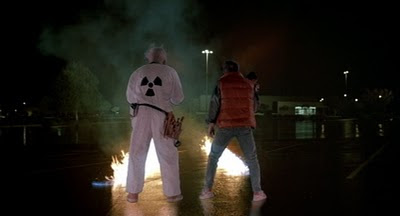 The first frame of the iconic Einstein time slice effect, featuring actors Christopher Lloyd and Michael J. Fox. The actors were shot against a bluescreen, standing on a mirror. The mirror gave the effects artists pristine reflections of the actors; the reflections were matted to separate them from the actors, and treated in the composite to appear as wet, pavement reflections by adding displacement and tweaking the brightness.
The first frame of the iconic Einstein time slice effect, featuring actors Christopher Lloyd and Michael J. Fox. The actors were shot against a bluescreen, standing on a mirror. The mirror gave the effects artists pristine reflections of the actors; the reflections were matted to separate them from the actors, and treated in the composite to appear as wet, pavement reflections by adding displacement and tweaking the brightness.
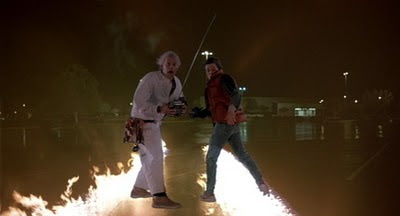 Michael J. Fox's screen right foot was placed behind fire licks via frame-by-frame rotoscoping. Areas of fire were articulated to bury Fox's foot within the fire. Like the previous two shots, the background plate was skip printed to give the fire trails more energy and speed.
Michael J. Fox's screen right foot was placed behind fire licks via frame-by-frame rotoscoping. Areas of fire were articulated to bury Fox's foot within the fire. Like the previous two shots, the background plate was skip printed to give the fire trails more energy and speed.
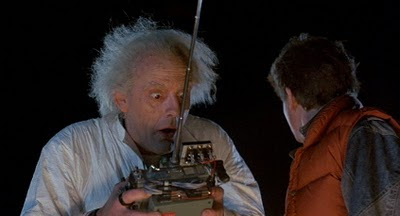 "What did I tell you?!?"
"What did I tell you?!?"
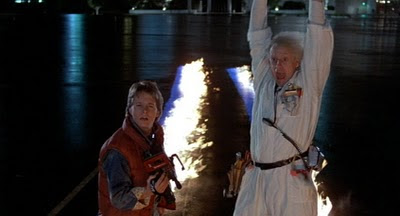 "Eighty eight miles per hour!!" This shot is entirely in-camera. The fire trails are a practical effect, just like all of the previous shots. In the sequence, the trails have been fully formed, and are no longer being generated; as a result, there was no need to skip print the trails for this shot.
"Eighty eight miles per hour!!" This shot is entirely in-camera. The fire trails are a practical effect, just like all of the previous shots. In the sequence, the trails have been fully formed, and are no longer being generated; as a result, there was no need to skip print the trails for this shot.
Here's an objective breakdown of "Back to the Future"'s first big effects sequence, the first time slice of the movie that sends Einstein the dog forwards in time.




 Real photographic background plate of Delorean, with glows and time slice animation created by the animation department at Industrial Light & Magic.
Real photographic background plate of Delorean, with glows and time slice animation created by the animation department at Industrial Light & Magic. The fire and sparks (and their reflections) were created on the set with special effects rigs attached to the Delorean.
The fire and sparks (and their reflections) were created on the set with special effects rigs attached to the Delorean.

 A large strobe light on location provided bright interactive light. Full frame flashing was also achieved in the optical composite.
A large strobe light on location provided bright interactive light. Full frame flashing was also achieved in the optical composite. Hey, look in the upper left corner of the screen. Say hi to the crew!
Hey, look in the upper left corner of the screen. Say hi to the crew!


 Panning left with Delorean. The car is actually on the set, with animation and effects added optically.
Panning left with Delorean. The car is actually on the set, with animation and effects added optically. The pan reveals bluescreen-photographed Marty and Doc. The actors were tracked and matted into the shot.
The pan reveals bluescreen-photographed Marty and Doc. The actors were tracked and matted into the shot.

 Pan abruptly stops, explosions and flares optically composited to represent time slice effect.
Pan abruptly stops, explosions and flares optically composited to represent time slice effect.
 First visible frame of explosion element. The main explosion element has a faked reflection in the wet ground, achieved in the optical composite.
First visible frame of explosion element. The main explosion element has a faked reflection in the wet ground, achieved in the optical composite. Explosion element runs backwards, giving the impression of an implosion. On-location, live-action ignition of fire trails appear, and are skip printed to appear to ignite much faster than reality would allow, approximating the feeling of 88mph.
Explosion element runs backwards, giving the impression of an implosion. On-location, live-action ignition of fire trails appear, and are skip printed to appear to ignite much faster than reality would allow, approximating the feeling of 88mph. Marty's foreground foot is rotoscoped to allow the fire trail to appear behind his leg.
Marty's foreground foot is rotoscoped to allow the fire trail to appear behind his leg.
 The last frame of the shot.
The last frame of the shot. In-camera effect, featuring on-set fire trails, using stunt performers.
In-camera effect, featuring on-set fire trails, using stunt performers. This shot was skip printed in post production to give the ignition the feeling of greater velocity, giving the impression of the Delorean continuing its 88mph journey in a parallel dimension of time. As a result, the fire's motion is somewhat strobey.
This shot was skip printed in post production to give the ignition the feeling of greater velocity, giving the impression of the Delorean continuing its 88mph journey in a parallel dimension of time. As a result, the fire's motion is somewhat strobey. Notice the relative exposure difference between this shot and the shots preceeding and following it. In this shot, the cinematographer exposed the film to feature the fire (or was underexposed in the colortiming or visual effects process), which reveals the internal structure of the fire. In the shots before and after, the actors and environment were the target exposure values; consequently, in those shots, the fire is blown out and overexposed, leaving only hot white fire shapes.
Notice the relative exposure difference between this shot and the shots preceeding and following it. In this shot, the cinematographer exposed the film to feature the fire (or was underexposed in the colortiming or visual effects process), which reveals the internal structure of the fire. In the shots before and after, the actors and environment were the target exposure values; consequently, in those shots, the fire is blown out and overexposed, leaving only hot white fire shapes. The first frame of the iconic Einstein time slice effect, featuring actors Christopher Lloyd and Michael J. Fox. The actors were shot against a bluescreen, standing on a mirror. The mirror gave the effects artists pristine reflections of the actors; the reflections were matted to separate them from the actors, and treated in the composite to appear as wet, pavement reflections by adding displacement and tweaking the brightness.
The first frame of the iconic Einstein time slice effect, featuring actors Christopher Lloyd and Michael J. Fox. The actors were shot against a bluescreen, standing on a mirror. The mirror gave the effects artists pristine reflections of the actors; the reflections were matted to separate them from the actors, and treated in the composite to appear as wet, pavement reflections by adding displacement and tweaking the brightness. Michael J. Fox's screen right foot was placed behind fire licks via frame-by-frame rotoscoping. Areas of fire were articulated to bury Fox's foot within the fire. Like the previous two shots, the background plate was skip printed to give the fire trails more energy and speed.
Michael J. Fox's screen right foot was placed behind fire licks via frame-by-frame rotoscoping. Areas of fire were articulated to bury Fox's foot within the fire. Like the previous two shots, the background plate was skip printed to give the fire trails more energy and speed. "What did I tell you?!?"
"What did I tell you?!?" "Eighty eight miles per hour!!" This shot is entirely in-camera. The fire trails are a practical effect, just like all of the previous shots. In the sequence, the trails have been fully formed, and are no longer being generated; as a result, there was no need to skip print the trails for this shot.
"Eighty eight miles per hour!!" This shot is entirely in-camera. The fire trails are a practical effect, just like all of the previous shots. In the sequence, the trails have been fully formed, and are no longer being generated; as a result, there was no need to skip print the trails for this shot.In a future post, I hope to dissect the shots more thoroughly from a subjective point of view, and expand upon ideas Mark, Mike and I discussed on the podcast.
Subscribe to:
Comments (Atom)
